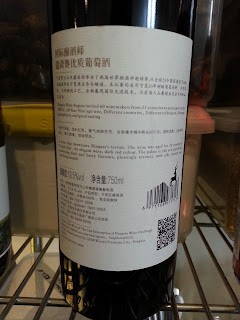I make no secret of it that I think Craggy Range is one of
New Zealand’s best wine producers.
Starting from scratch in the late 1990s, planting vines then making
wines, Steve Smith MW was the driving force behind the incredible progress the
wines and brand made both domestically and overseas.
The first releases were ‘statement’ wines,
about as big and bold as you could make them.
They were almost Californian in showiness.
But they were balanced and tasty, and you
knew they would last.
The production of Craggy Range is geared towards the
Merlot-based ‘Sophia’ first and foremost, though there are proponents for ‘Le
Sol’ Syrah and maybe ‘Les Beaux Cailloux’ Chardonnay as the best wine. The latter wine is in a hiatus, as the
original vines, affected by virus, were grubbed up. Make no mistake about it, the majority of the
production of the ‘Prestige Collection’ wines is ‘Sophia’. Remarkably it isn’t as expensive as the other
reds in the ‘Collection’.
Nowadays, the style of ‘Sophia’ is much more refined. It isn’t a little wine by any means, and it
is still very serious, very structured, and built to last, while developing
great layers of flavours and indeed complexities. The 2015 has just been released, so I can’t
speak to it as I haven’t tasted it.
There’s a bottle in my ‘wait box’ though. But the 2014 and 2013 were stunningly refined
and rich, but in no way showed excesses. Just how far the style has been adjusted and
refined can be seen if one tastes the earlier wines. It just so happens that I’ve drunk the 2009
and the 2001 recently.

The 2009 Craggy Range
‘Sophia’ ‘Gimblett Gravels Vineyard’ Hawke’s Bay Merlot/Cabernet came from
a very warm and dry growing season. The
wines have generally turned out big, black, sweetly ripe and structured. The wines had brightness and energy, and
quite masculine. The ‘Sophia’, though
with a feminine name was exactly that on release. It was a stunningly gorgeous and decadent
wine, with great potential. On this
opening, it was still black-red in colour, near impenetrable, though the purple
flush of youth had faded. On nose and
palate, the fruit was rich and sweetly ripe with dark plums, hints of
liquorice, maybe a touch of currant and cassis, but in no way showing coolness. What it did show surprisingly, was style and
a sense of restraint. Not quite
refinement, but a composure and a nod toward possible elegance. The tannins were considerable, but very ripe
and fine-grained, and the acidity totally integrated. Only the merest hint of some development
emerged in the glass. It was a glorious
bottle to drink, and should have been decanted.
It you didn’t take a step back to appreciate it, you could have missed
how it had become so stylish.

Then the 2001 Craggy
Range ‘Sophia’ ‘Gimblett Gravels Vineyard’ Hawke’s Bay Merlot/Cabernet. This was the first release. It was a true showpiece wine. It was as bold and gutsy, and marked by as
much new oak smells and tastes as the Syrah and Cabernet-based wine. Steve Smith and his winemaking team held
nothing back to make it impenetrable and black-purple in colour, totally
nostril and mouthfilling, coasting all the senses with decadence and
opulence. It is a giant among
giants. On opening 15 years down the
track, it was still impenetrable in colour.
Only on the edge or when the glass got lower could you see garnet and
brick to the black. Again, massively ripe-fruited
with black plums, now going down the Dutch liquorice path. Layers of black fruits unfolding earth and
undergrowth, laced with cedary oak. The
palate just simply overwhelming in flavour, yet so drinkable. Still plenty of tannin extraction and grip,
but this too was ripe and fine, beginning to resolve. This was sipping and meditation material, not
gulping and gusto wine. It was a monster
then. It still is a monster, but a
loveable one. We were truly monstered.




































